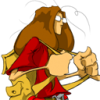Like I said in my other topic:
Even going beyond the tactics game style, how one go about computing how much of someones volume/silhouete is visible from a point of view?
It sounds very complex to me, makes me think that most tactics games probably cheat a lot with this, like making very limited level design, or not taking much into consideration...
I started thinking on this with the idea of having spheres characters moving on world made of AABBs, but the boxes not needing to be aligned with anything, and can be positioned freely also in vertical, so I dont think its possible to have some hackish way of doing this?
The simplest way I though of is shooting a lot of minimum size projectils against the target in a way that it would hit the target evenly all over its circle silhouete, and see how much of the projectiles actually hit..
The other way is image based: render the target only in a unique color, count its pixels, render all obstacles, depth enable, ortho camera (on the pos of the gun barrel), and count the pixels of the target again?
Am I overthinking this? How youd do it?






